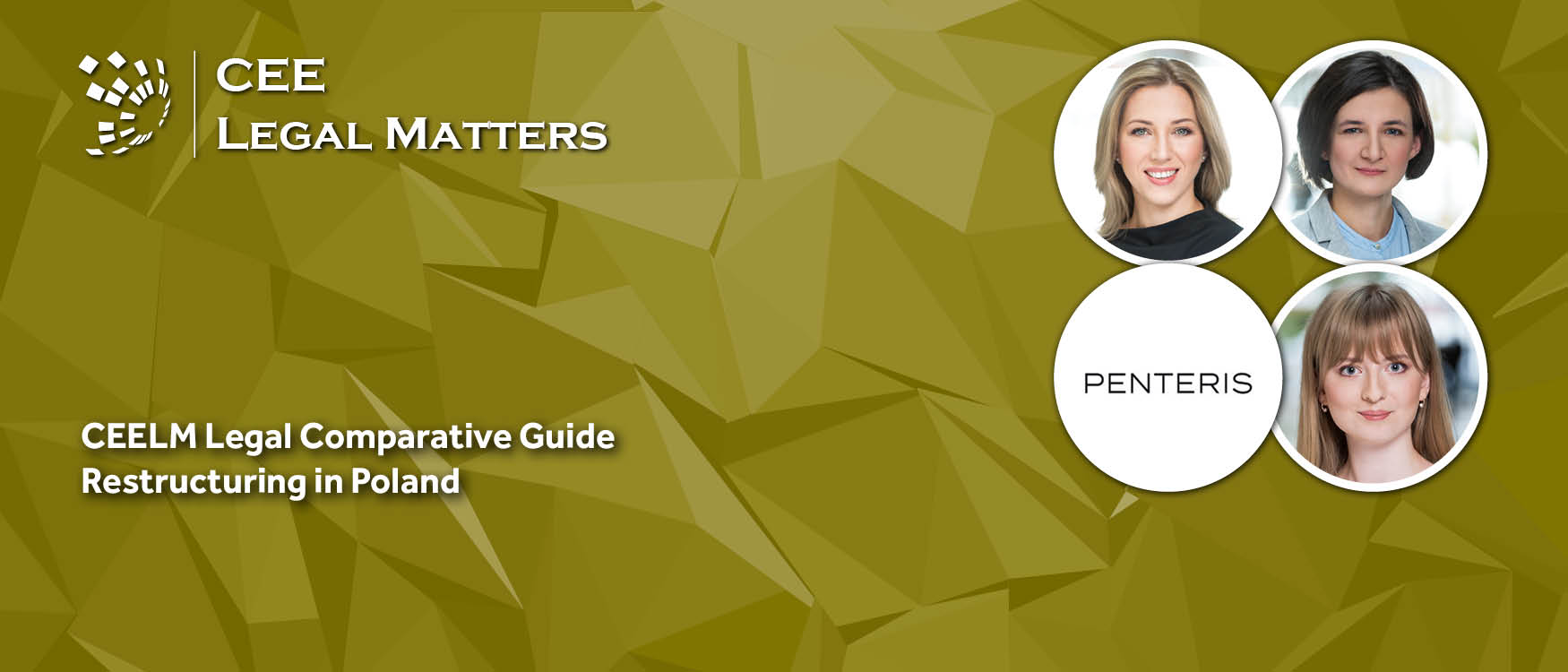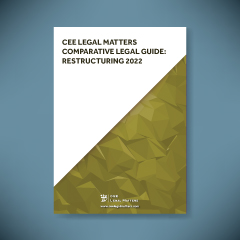Contributed by Penteris.
1. Overview
1.1. What domestic pieces of legislation and international instruments apply to restructuring and insolvency matters in your jurisdiction?
Polish insolvency and restructuring proceedings are primarily regulated by the Bankruptcy Law of February 28, 2003 (Bankruptcy Law) and the Restructuring Law of May 15, 2015 (Restructuring Law). While an autonomous legal act concerning the Restructuring Law was adopted relatively recently, prior to that date, restructuring proceedings were regulated under the Bankruptcy Law.
In June 2020, an additional type of restructuring proceedings (i.e. simplified restructuring proceedings) was introduced by legislation known as Shield 4.0. It was partially an answer to the COVID-19 pandemic and also – as it became a permanent fixture to the restructuring law – the ongoing demand for a less court-controlled procedure that would ensure that proceedings are completed quickly and are easily accessible.
As regards international instruments applying to cross-border insolvency matters, the key legislation is the EU Regulation on Insolvency Proceedings (Regulation no. 848/2015, – EIR). It is also good to remember that Polish Bankruptcy Law implements Cross-Border Insolvency Regulations 2006 (CBIR 2006) while the decision on opening insolvency proceedings in the UK will not be directly recognized by Polish courts, it should make it easier to complete such a procedure.
1.2. Do you have a well-established legal regime governing restructuring and insolvency, or do you have rather frequent legislative changes in the area?
The insolvency and restructuring law in Poland is still evolving and the changes made thereto are usually a result of the implementation of EU law or – as the last few years have shown – a response to changes in the demands of the evolving market.
An example of the former would be the upcoming implementation of the EU’s Restructuring and Insolvency Directive (2019/1023) and of the latter – both an introduction of new simplified restructuring proceedings and new provisions speeding up bankruptcy procedures of natural persons carrying out no economic activity, each introduced in 2020.
1.3. Are there any special regimes applying to specific sectors?
There are certain entities and their categories that are excluded from bankruptcy and restructuring proceedings. For example, public autonomous health care centers, higher education schools, or investment funds cannot be declared bankrupt, while such entities as state banks and mortgage-lending banks, insurance establishments, and reinsurance establishments cannot be subject to restructuring proceedings.
There are also separate bankruptcy proceedings, including in particular against developers, banks and credit unions, insurance and reinsurance undertakings, and bond issuers. In the case of restructuring proceedings, there are special regimes for developers and bond issuers.
1.4. Were any changes to restructuring or insolvency laws adopted in response to the COVID-19 pandemic? If so, what were they?
Not long after the beginning of the COVID-19 pandemic in Poland, on April 13, 2020, a moratorium on the filing of bankruptcy declarations was introduced.
In accordance with Polish law, there is a 30-day deadline for a company to file for a declaration of bankruptcy (or restructuring) once the company becomes insolvent. If the obliged representatives (e.g., Management Board) miss the deadline, they may become liable for the company’s debts.
To avoid a situation where the courts are flooded with bankruptcy applications, the so-called moratorium stipulated that if insolvency arose during the COVID-19 pandemic (with the presumption that any insolvency that arose during a state of epidemic appeared due to COVID-19), the 30-day deadline for a company to submit a bankruptcy application does not commence.
Furthermore, and as was already mentioned, in response to COVID-19, a new type of restructuring proceedings (i.e., simplified restructuring proceedings) was introduced. These proceedings enabled a debtor to initiate and conduct restructuring proceedings practically without a court review, with the court’s role limited only to the possible approval of the arrangement at the final stage of the restructuring proceedings. While at first it was a temporary solution, due to its popularity and the clear demand for such simplified proceedings (in accordance with the statistics it accounted for approximately 80% of restructuring proceedings in Poland), it has now found its place in the Restructuring Law for good.
1.5. Are there any proposed or upcoming changes to the restructuring insolvency regime in your country?
The EU’s Restructuring and Insolvency Directive (2019/1023) has not been implemented in Poland yet, but the first draft of the implementation act was published in July 2022. The deadline to implement the directive expired on July 17, 2022, but considering that the draft was published only recently, it is highly likely that the implementation of the act will take place in the fourth quarter of 2022 if not later.
Implementing the directive will undoubtedly bring numerous changes to existing legislation, but at the same time – despite the directive still awaiting implementation, the Restructuring Law and Bankruptcy Law already regulates a host of solutions introduced therein.
1.6. Has your country adopted or is your country considering the adoption of the UNCITRAL Model Law on Enterprise Group Insolvency?
The UNCITRAL Model Law on Enterprise Group Insolvency was not adopted in Poland and, so far, no formal drafts were published.
2. Insolvency
2.1. Is there an insolvency test that triggers certain obligations for directors or officers of the debtor company? If so, what is the test and what are the consequences for failure to meet these obligations?
There are two insolvency tests:
a. liquidity test which is met when the debtor is unable to pay its overdue debts and the delay in payment exceeds three months;
b. balance sheet test which is met when:
i. the debtor becomes over-indebted, i.e., if, according to the debtor’s balance sheet, its obligations, excluding balance-sheet provisions for obligations and liabilities towards affiliates, exceed the value of its assets; and
ii. if the above situation continues uninterruptedly for longer than 24 months.
This test does not apply to all entities, but it does apply to companies and/or certain partnerships.
The Management Board of an insolvent company is obliged to file a bankruptcy petition within 30 days of the fulfillment of either of the insolvency tests. The members of the Management Board are liable for any damage caused as a result of their failure to file a petition within the time limit unless they are not at fault.
It is important to note that in such a situation, the Management Board would be liable only for the damages calculated as a difference between the amount that could have been obtained in the proceedings if the petition was filed on time and on the date of filing the petition.
Furthermore, members of the Management Board may also be prohibited from holding managerial positions or conducting business activity for a period of one to 10 years in the case of, among other, willful failure to file for bankruptcy in the event of the company’s insolvency.
2.2. What types of insolvency procedures are established by law in your jurisdiction?
Currently, there is only one type of insolvency procedure, i.e., liquidation bankruptcy.
Bankruptcy proceedings can only be initiated in relation to a debtor who has become insolvent (i.e., as opposed to a debtor only threatened with insolvency which is the case with restructuring proceedings).
In those proceedings, the satisfaction of the claims of the creditors of a given company is possible through the liquidation (compulsory sale) of the bankrupt’s assets. It is necessary to appoint a receiver (syndyk), who manages the assets of the bankrupt, and then brings the entire process of liquidation of the company to a conclusion. The bankrupt is deprived of the right to manage and dispose of the property.
The receiver sells movable and immovable property belonging to the bankrupt. The obtained funds of the bankruptcy estate are divided among the creditors on the basis of a previously prepared distribution plan. It is important to note that the creditors benefiting from a security interest enjoy priority in satisfaction to the extent covered by the secured assets. As a result, it is quite common that the majority of the liquidation proceeds from the bankruptcy sale of an asset (or the debtor’s business as a whole) are used to satisfy secured creditors.
However, it is also important to note that as part of the changes that came into force in 2016, the legislator introduced a new regulation within Bankruptcy Law, similar to the arrangement proceedings under Restructuring Law. This is the so-called arrangement in bankruptcy. This institution allows a bankrupt entity to enter into an arrangement with its creditors when, after the bankruptcy proceedings are opened, it turns out that it would be more advantageous for the creditors as a whole to be satisfied under the terms of an arrangement than through the sale of the bankrupt’s assets. In particular, the arrangement in bankruptcy is applicable in situations where it was not possible to open or continue restructuring proceedings, but already after the declaration of bankruptcy, there was a chance to save the bankrupt’s enterprise. In practice, however, such a situation is very rare and the application of arrangement provisions in bankruptcy is very limited.
2.3. Who has the right to initiate insolvency proceedings?
In order to initiate bankruptcy proceedings, a prerequisite is the filing of a petition by an authorized entity with a competent court. Bankruptcy proceedings are never initiated ex officio. Such an application may be filed by any creditor, and in the case of the existence of grounds for declaring bankruptcy, such an application is obligatorily filed by the debtor himself.
2.4. What are the consequences of commencing insolvency proceedings, in particular:
2.4.1. Does management continue to operate the business and/or is the debtor subject to supervision?
No, as of the date of the declaration of bankruptcy, the bankrupt entity loses the right to operate the assets comprising the bankruptcy estate and the possibility of using and disposing of them. Management of the property is assumed by the receiver, even when the assets have not been yet released to them. Any actions by the bankrupt entity regarding the bankruptcy estate are void – this includes actions regarding repayments made to the bankrupt entity, which should be addressed directly to the receiver.
2.4.2. Does a moratorium or stay apply and if so, can it have an extraterritorial effect?
Upon declaration of bankruptcy, court, administrative, as well as proceedings before administrative courts involving the bankruptcy estate may only be initiated and conducted by or against the receiver.
With respect to execution proceedings, the proceedings initiated prior to the declaration of bankruptcy shall be suspended by operation of law on the day of the declaration of bankruptcy. These proceedings shall be discontinued by operation of law after the ruling on the declaration of bankruptcy has become final and non-appealable. Furthermore, following the declaration of bankruptcy, no execution can be commenced against any part of the bankruptcy estate.
2.4.3. How does it impact the existing contracts (e.g., is the counter-party free to terminate them, can the debtor’s pre-insolvency transactions be challenged)?
There is a host of specific provisions regulating the impact that declaring bankruptcy has on existing contracts. There are a few general rules that are important to keep in mind:
a. acts (including contracts or, for example, court settlements) performed free of charge (or significantly undervalued) within one year before filing the bankruptcy petition, whereby the debtor disposed of its assets, may be challenged;
b. securities and payments of an unenforceable debt, given or made by the debtor within six months before filing the bankruptcy petition, are ineffective towards the bankruptcy estate;
c. the receiver may, with the prior consent of the judge-commissioner, perform the debtor’s obligation resulting from the contract and demand the other party to render reciprocal performance, or withdraw from the contract with effect as of the date of declaration of bankruptcy;
d. clause stipulating that a legal relationship to which the bankrupt is a party, may be modified or terminated if a bankruptcy petition is filed or if bankruptcy is declared, is invalid.
It is important to remember that the final result may differ depending on, for example, which party went into insolvency or whether the contract was at least partially performed.
However, should the contract become ineffective (either by operation of law or – with respect to the bankruptcy estate – based on the decision of the judge-commissioner), the other party would be obliged to contribute to the bankruptcy estate anything that has been transferred out of or has not been contributed to in result of an ineffective act.
2.5. Which steps do insolvency proceedings normally include and what are the roles of the courts and other key stakeholders (such as debtor, directors of the debtor, shareholders of the debtor, secured creditors, unsecured creditors, etc.)?
In general, there are two main stages of bankruptcy proceedings: stage one takes place after filing the bankruptcy petition, and stage two starts once the court issues the decision to open bankruptcy proceedings.
The court’s decision on opening bankruptcy proceedings is effective and enforceable as of the date of its issue. The date of the order is the date of declaring (opening) the bankruptcy which is important for calculating the deadlines mentioned in Section 2.4.
During stage one of the proceedings, an interim court supervisor (tymczasowy nadzorca sadowy) might be appointed. In such a case, the debtor can no longer dispose of its assets (outside the scope of day-to-day management) if no approval from the interim court supervisor is obtained. The debtor might be also deprived of its powers in full or other steps to secure the debtor’s assets might be undertaken.
Once bankruptcy proceedings are opened, the bankrupt loses the right to manage and the possibility to use and dispose of the property included in the bankruptcy estate, and the receiver takes control over the bankruptcy estate. The debtor is obliged to cooperate with the receiver and the court, specifically in terms of duties of disclosure and cooperation in order to assist the insolvency administrator with the fulfillment of its duties.
The key elements of the proceedings include (they usually take place at least partially simultaneously):
a. Submission of claims
A personal creditor of the bankrupt entity who wishes to participate in the bankruptcy proceedings should report their claim to the receiver.
There are few instances where despite the creditor’s failure to report their claim, the claim will be included in the list of claims ex officio – those cases include in particular claims secured by a mortgage, pledge, registered pledge, tax lien, maritime mortgage, or by another entry in the land register or the ship’s registry, and if it arises from an employment relationship. Creditors in rem are included in the list of creditors ex officio.
b. List of claims
After the expiration of the deadline for submission of claims and verification thereof, the receiver is obliged to prepare a list of claims. After it is prepared, the receiver submits it to the judge-commissioner. Upon its approval by the judge-commissioner, information on the preparation of the list of claims is announced. Within two weeks of the announcement, a creditor may file an objection if their claim was recognized only in part or not at all.
c. Determination of the composition of the bankruptcy estate
With certain exceptions, as of the date of bankruptcy, the bankrupt entity’s assets become the bankruptcy estate, which serves to satisfy the bankrupt entity’s creditors. In order to determine what assets are included in the bankruptcy estate, the trustee prepares an inventory and an inventory of accounts receivable. These assets, after their liquidation, will serve to satisfy creditors.
d. Liquidation of the bankruptcy estate
Once bankruptcy proceedings are opened, the receiver also proceeds to draw up a liquidation plan, which specifies the proposed means of selling the bankrupt entity’s assets, in particular the sale of the business, the timing of the sale, an estimate of expenses, and the economic justification for the continued operation of the bankrupt entity’s business.
Liquidation of the bankruptcy estate is carried out either by selling the bankrupt entity’s assets or by collecting debts from the bankrupt entity’s debtors and exercising its other property rights. When liquidating the bankruptcy estate, the main focus of the receiver should be the welfare of the creditors, including in particular their level of satisfaction.
e. Distribution of funds among creditors
The distribution of funds shall be made either once or several times as the bankruptcy estate is liquidated. In each case, a plan of distribution is drawn up.
Distribution takes place several times usually in cases where the assets are liquidated separately and/or there are secured creditors in which case separate distribution plans are usually prepared for each liquidated secured asset.
As for non-secured creditors, the trustee distributes the sums among them in accordance with the rules provided by the Bankruptcy Law, i.e.: (i) creditors are divided into four categories, (ii) until creditors in a higher category are satisfied in full, no creditors in a further category may be satisfied, (iii) within one category, creditors are satisfied in proportion to the amount of their claim.
f. Closing the proceedings
In the standard case, upon execution of the final distribution plan, the court declares that the insolvency proceedings have ended.
2.6. In insolvency proceedings, do specific stakeholders’ claims enjoy priority (e.g., employees, pension liabilities)? Can the claims of any class of creditor be subordinated (e.g., equitable subordination)?
Under the Bankruptcy Law, secured creditors enjoy preferential treatment with regard to the liquidation of secured assets. These creditors enjoy priority in satisfaction to the extent covered by the secured assets (excluding costs of liquidation of the secured asset and other costs of bankruptcy proceedings determined in accordance with the Bankruptcy Law).
The remaining claims are divided into four categories, as listed below:
I. the first category – among others: employees’ claims (with exceptions, such as in particular claims for remuneration of the bankrupt entity’s representative or remuneration of the person performing acts connected with administration or supervision over the bankrupt entity’s enterprise), maintenance claims and workers’ compensation, social security contributions defined in the Social Security System, particular amounts resulting from restructuring proceedings of the debtor;
II. the second category – other receivables if they are not subject to satisfaction in other categories, in particular taxes and other public tributes, and the remaining receivables under social insurance premiums;
III. the third category – interest on receivables included in higher categories in the order in which the principal is subject to satisfaction, as well as judicial and administrative penalties of fine, and receivables in respect of donations and legacies;
IV. the fourth category – receivables of shareholders under a loan or another act in law of similar effects, in the particular supply of goods with deferred due date made to the bankrupt entity being a company in the period of five years before the declaration of bankruptcy, along with interest.
The claims are satisfied in accordance with rules described in Section 2.5.e. The main rule is to satisfy the costs of proceedings and other liabilities of the bankruptcy estate. There are also some additional, specific provisions concerning the liquidation of the bankruptcy estate in the case where a bankrupt entity is a natural person and the bankruptcy estate includes a flat in which the bankrupt entity lives since it is necessary to meet the housing needs of the bankrupt entity and its dependents.
2.7. What is a timeline for insolvency proceedings and how are they finalized?
Currently, the estimated time of insolvency proceedings in Poland is up to a few years. Typically, once the list of claims is approved and the final distribution plan is executed, the court declares that the insolvency proceedings have ended.
In the case of legal entities, once the court’s decision becomes final and binding, they are deregistered. If any assets are left, they are distributed among the stakeholders or the company may continue its existence (provided that the shareholders take action quickly enough).
2.8. Are there any liabilities that survive the insolvency proceedings?
Where legal entities are concerned, no liabilities survive the insolvency proceedings – if the bankrupt entity’s assets are not sufficient to satisfy all of its creditors, such an entity is deregistered upon completion of the proceedings.
In the case of natural persons, the situation is different and there are certain categories of liabilities that survive the proceedings, in particular: (i) obligations on the grounds of maintenance or alimony; (ii) obligations to pay the fines pronounced by a court, to discharge the duty of redressing damages and of compensating for the wrong suffered; (iii) the obligation to pay punitive damages or a pecuniary benefit, as pronounced by a court as a criminal measure or a measure connected with subjecting a perpetrator to probation; (iv) obligations which the bankrupt entity has not disclosed intentionally, provided that the creditor did not participate in the proceedings.
3. Restructuring
3.1. What formal and informal restructuring proceedings are available in your country?
In Poland, there are four types of formal restructuring proceedings regulated by the Act of May 15, 2015 – Restructuring Law, i.e.:
1) arrangement approval proceedings (postepowanie o zatwierdzenie ukladu) – allows an arrangement with creditors with minimal court involvement; it is dedicated to debtors who are able to reach an agreement with the majority of their creditors without court involvement;
2) accelerated arrangement proceedings (przyspieszone postepowanie ukladowe) – characterized by a number of simplifications, which are designed to bring about an arrangement with creditors in the shortest possible time, assumed to be about 2-3 months;
3) arrangement proceedings (Pol. postepowanie ukladowe) – dedicated only to those debtors that are in dispute with their counterparties, i.e., do not recognize the obligation to pay certain monetary obligations and do not meet the criteria for implementing the arrangement approval procedure and the accelerated arrangement procedure;
4) remedial proceedings (Pol. postepowanie sanacyjne) – provides the fullest protection against execution, under this procedure, the debtor cannot only restructure the debt but also bring about economic recovery by carrying out remedial measures that interfere with the structure of the enterprise.
Informal restructuring proceedings in Poland are carried out without court involvement and without following any statutory procedures. This involves the debtor negotiating with his creditors to sign an agreement setting out the terms of restructuring existing debt.
3.2. What are the entry requirements to restructuring and how are restructuring plans approved and implemented?
The entry requirements to restructuring are the insolvency of a debtor or the risk of insolvency of a debtor and the filing of a restructuring application by such a debtor to the restructuring court (the district court – commercial court).
An integral part of the application is the initial restructuring plan prepared by the debtor.
The legislation does not impose a specific deadline for filing a restructuring application. However, it is in the interest of the debtor to file a restructuring application as soon as possible after the risk of insolvency has been established.
In proceedings for approval of an arrangement, accelerated arrangement proceedings, and arrangement proceedings, the commencement of implementation of the restructuring plan is not conditional on its approval by an order of the judge-commissioner or the restructuring court.
In contrast, in remedial proceedings, the prerequisite for implementing the restructuring plan is its approval by the judge-commissioner. Indeed, in a remedial procedure, approval of the plan is a condition for taking such measures as downsizing, disposal of property, or withdrawal from certain contracts.
The restructuring authorities, i.e., the administrator, the court supervisor, and the supervisor of the arrangement are responsible for the proper implementation of the restructuring plan.
3.3. Who has the right to initiate formal restructuring proceedings?
The right to initiate formal restructuring proceedings lies with an insolvent debtor or a debtor at risk of insolvency.
The initiation of remedial proceedings may additionally be carried out by a personal creditor of the insolvent debtor, which is a legal person, and the curator of a legal person registered in the National Court Register.
3.4. What are the consequences of commencing restructuring proceedings, in particular:
3.4.1. Does management continue to operate the business and/or whether the debtor is subject to supervision?
In proceedings for the approval of an arrangement, accelerated arrangement proceedings, and arrangement proceedings, the management shall continue to operate the business, with the proviso, however, that any acts exceeding the scope of ordinary management shall require the consent of the restructuring authority (e.g., the disposal of substantial assets or the conclusion of a new contract).
In remedial proceedings, as a general rule, the court removes the ability of the management to carry out operational business and appoints an administrator for this purpose.
3.4.2. Does a moratorium or stay apply, and, if so, what is its scope?
The statutory suspension of the debtor’s or the administrator’s performance of obligations that are covered by the arrangement shall apply throughout the restructuring proceedings. The statutory suspension of the performance of obligations may not be lifted even with the mutual consent of the debtor and the creditor. From the date of the opening of restructuring proceedings until the date of their completion, the fate of debts will be determined by the concluded arrangement.
The provisions of the Restructuring Law also provide for the suspension of enforcement proceedings conducted so far with respect to the liabilities covered by the arrangement (unlike in the remedial proceedings, where the possibility of conducting enforcement proceedings has been excluded as a rule), as well as the prohibition of initiating new enforcement proceedings.
3.4.3. How do restructuring proceedings affect existing contracts?
The purpose of restructuring proceedings is to avoid bankruptcy, so the legislator has introduced the so-called “contract durability compulsion.” This means that from the date of the opening of restructuring proceedings, it is not permissible to terminate a lease or rental agreement, a credit agreement, a leasing agreement, a property insurance agreement, a bank account, a suretyship, a guarantee, or a letter of credit.
Within the framework of the remedial procedure, the legislator has granted the debtor the unilateral right to terminate reciprocal contracts that have proven to be unprofitable or too costly for the debtor’s assets. Furthermore, in the remedial procedure, the debtor has been equipped with the right to terminate employment contracts and even to rescind non-compete agreements without being entitled to compensation.
3.4.4. How are existing contracts treated in restructuring and insolvency processes?
With regard to restructuring, see Section 3.4.3.
With regard to insolvency proceedings, some of the contracts expire automatically. Among the most relevant contracts that expire on the date of bankruptcy, we can distinguish: contracts of mandate or commission, where the bankrupt entity was the principal or commissary; agency agreements; loan agreements, when the object of lending has not been handed over; loan agreements if the object of the loan has not been disbursed; loan agreements to the extent that the funds have not been transferred to the bankrupt entity; storage agreements concluded with a bank.
The bankruptcy declaration has no automatic effect on the bankrupt entity’s property lease agreement. The agreement binds the parties as long as the property has been released to the tenant. However, the trustee may terminate this type of agreement with three months’ notice, also if the agreement did not provide for this possibility. The agreement is terminated by order of the judge-commissioner if its continuance hinders the liquidation of the bankruptcy estate or if the rent is underestimated.
The same applies to the lease agreement of the bankrupt entity’s real estate and the lease or rental agreement of the enterprise or its organized part.
The trustee may also terminate a lease or tenancy agreement in which the bankrupt entity is a tenant (lessee).
With regard to other contracts, it is up to the trustee to decide whether to terminate the contract or continue to perform it. These are mainly reciprocal contracts, e.g., a sales contract, a work contract, or a construction contract.
3.5. Can third-party liabilities be released through restructuring proceedings?
Through restructuring proceedings, only the debtor’s liabilities may be released.
3.6. Which steps do restructuring proceedings normally include and what are the roles of the courts and other key stakeholders (such as debtor, directors of the debtor, shareholders of the debtor, secured creditors, unsecured creditors, etc.)?
The first step is a thorough analysis of the company’s situation by the debtor and the restructuring advisor and the completion and development of relevant documentation, in particular a description of the company, a preliminary restructuring plan, arrangement proposals, an up-to-date list of assets, a list of creditors, a list of claims and disputed claims.
The completed documentation is submitted by the debtor to the court together with the application for restructuring.
Subsequently, the court considers the restructuring application and opens the proceedings.
At the same time, the court appoints a court supervisor or administrator.
The court supervisor or administrator notifies all known creditors of the opening of the restructuring proceedings, whom he/she instructs about the changes brought about by the restructuring in the sphere of the debtor’s liabilities and assets. This is the first formal letter addressed to the creditors.
Next, the court supervisor or administrator prepares the restructuring plan and draws up the arrangement proposals.
The next step is to draw up a list of claims and an inventory of disputed claims, as well as an inventory (except in the case of accelerated arrangement proceedings) by the court supervisor or administrator.
The list of creditors drawn up must be approved by the judge-commissioner.
At the stage of establishing the inventory of claims in the arrangement and remedial proceedings, the creditor has the right to file an objection, which is considered by the judge-commissioner. The creditor also has the right to request a statement of reasons for the decision and to bring a complaint against the decision. The debtor has the right to file objections to the disputed claims. If the judge-commissioner grants the debtor’s request, amendments will be made.
This is followed by the judge-commissioner setting a date for a creditors’ meeting to vote on the arrangement. At this meeting, the creditors’ acceptance or refusal of the arrangement takes place.
If they accept, the court approves the arrangement, which ends the proceedings. The court may also refuse to approve the arrangement and discontinue the proceedings.
3.7. How are restructuring proceedings normally finalized?
Restructuring proceedings are normally finalized with the approval of an arrangement with creditors by the court or discontinuance of the proceedings.
Arrangement approval proceedings, in which entities come to court with an already approved arrangement, have the highest efficiency, calculated as the ratio of approved arrangements to discontinued proceedings.
4. Cross-border restructuring and insolvency
4.1. Do domestic courts in your country recognize foreign insolvency or restructuring proceedings over a local debtor?
Polish courts have exclusive jurisdiction over bankruptcy and restructuring proceedings concerning debtors that have their center of main interests in Poland (a jurisdiction agreement does not apply).
Recognition of foreign restructuring and bankruptcy proceedings may take place if it concerns a case that does not fall within the exclusive jurisdiction of Polish courts, i.e., may take place in cases where proceedings concern a debtor who conducts business activities in Poland that is not the center of its main interests in Poland or has their place of residence and/or registered office or assets in Poland. This is the so-called “optional jurisdiction” of the Polish courts.
4.2. What are the preconditions for recognizing foreign decisions?
A foreign decision on the opening of restructuring and insolvency proceedings is subject to recognition if it concerns a case that does not fall within the exclusive jurisdiction of the Polish courts (See Section 4.1).
In the case of bankruptcy proceedings, the Polish legislator has additionally specified the premise of compliance with the fundamental principles of the legal order in Poland.
4.3. Do domestic courts cooperate with their counterparts in other jurisdictions and if so, what does such recognition depend on (such as the COMI of the debtor, the governing law of the debt to be compromised, etc.)?
When parallel restructuring and insolvency proceedings are conducted (in cases not subject to the exclusive jurisdiction of the Polish courts), international cooperation of the authorities of these proceedings is necessary to ensure the efficient and effective conduct of restructuring and bankruptcy and to avoid double satisfaction of creditors. This means that the court and especially the judge-commissioner has an obligation to cooperate with the foreign court and administrator. However, this does not mean that this cooperation must always be direct. When choosing certain methods and forms of cross-border cooperation, the court and the judge-commissioner should bear in mind the postulate of efficiency in the application of the law. According to this postulate, judicial authorities of the proceedings should use such methods of cooperation that will have an effect to achieve the desired state of affairs, which means that the scope and forms of cooperation may vary depending on the needs of the specific proceedings. The first and essential element guaranteeing effective cooperation is the possibility of direct communication. Hence, the court and the judge-commissioner may communicate directly with a foreign court and a foreign administrator, including by telephone, fax, or e-mail, and the court supervisor or administrator appointed in restructuring proceedings and the trustee appointed in bankruptcy proceedings will be able to communicate with the foreign court and the foreign administrator directly or through the judge-commissioner.
4.4. How are foreign creditors treated in restructuring and insolvency proceedings in your jurisdiction?
In restructuring and insolvency proceedings, a foreign creditor shall use the rights enjoyed by a local creditor. An additional obligation of foreign creditors is to designate an attorney for service in Poland if no attorney has been appointed to pursue the case.
5. Summary
5.1. Overall, do you have a more creditor-friendly or debtor-friendly restructuring and insolvency regime in your jurisdiction?
There is a more debtor-friendly restructuring regime in Poland. The premise of restructuring law regulations is to increase the powers of the debtor at the expense of creditors or the court. Judicial authorities, if at all, only resolve disputes. Bankruptcy procedures are slightly different and favor the debtor’s creditors to a large extent.






